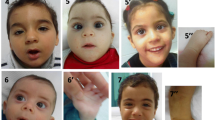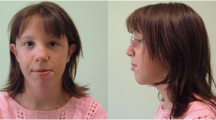Abstract
We report a de novo supernumerary isochromosome 18p in a child with tetrasomy 18p, analyzed by a straightforward combination of cytogenetic and molecular cytogenetic methods. The diagnostic procedure consisted of standard banding techniques and fluorescence in situ hybridization (FISH) with centromere and library DNA probes for chromosome 18, and 18p-specific FISH probes prepared by chromosome microdissection and in vitro amplification. The maternal origin as well as the most probable cell stages of formation of the supernumerary isochromosome were determined by typing of short sequence repeats (SSRs). The pattern of allelic distribution suggests a nondisjunction during meiosis followed by a centromeric misdivision in an early postzygotic mitosis as the most probable mode of isochromosome 18p formation. The combination of the applied methods represents a powerful tool to investigate the nature and the origin of de novo marker chromosomes.
Similar content being viewed by others
References
Abeliovich D, Dagan J, Levy A, Steinberg A, Zlotogora J (1993) Isochromosome 18p in a mother and her child. Am J Med Genet 46:392–393
Callen DF, Freemantle CJ, Ringenbergs ML, Baker E, Eyre HJ, Romain D, Haan EA (1990) Isochromosome 18p syndrome: confirmation of cytogenetic diagnosis in nine cases by in situ hybridization. Am J Hum Genet 47:493–498
Dyke DL van, Babu VR, Weiss L (1987) Parental age, and how extra isochromosomes (secondary trisomy) arise. Clin Genet 32:75–80
Froland A, Holst G, Terslev E (1963) Multiple anomalies associated with an additional small metacentric chromosome. Cytogenet Cell Genet 2:99–106
Göcke H, Muradow I, Zerres K, Hansmann M (1986) Mosaicism of isochromosome 18p: cytogenetic and morphological findings in a male fetus at 21 weeks. Prenat Diagn 6:151–157
Gyapay G, Morissette J, Vignal A, Dib C, Fizames C, Millasseau P, Marc S, Bernardi G, Lathorp M, Weissenbach J (1994) The 1993–94 Généthon human genetic linkage map. Nat Genet 7: 246–339
Kessel AG van, Straub RE, Silverman GA, Gerken S, Overhauser J (1994) Report of the second international workshop on human chromosome 18 mapping. Cytogenet Cell Genet 65:142–163
Müller SA, Dykes DD, Polesky HF (1988) A simple salting out procedure for extracting DNA from human nucleated cells. Nucleic Acids Res 16:1215
Müller-Navia J, Nebel A, Schleiermacher E (1995) Complete and precise characterization of marker chromosomes with microdissection in prenatal diagnosis. Hum Genet 96:661–667
Pinkel D, Straume T, Gray JW (1986) Cytogenetic analysis using quantitative, high sensitivity fluorescence in situ hybridization. Proc Natl Acad Sci USA 83:2934–2938
Rivera H, Möller M, Hernandez A, Enriquez-Guerra MA, Arreola R, Cantù JM (1986) Tetrasomy 18p: a distinctive syndrome. Ann Genet 27:187–189
Takeda K, Okamura T, Hasegawa T (1989) Sibs with tetrasomy 18p born to a mother with trisomy 18p. J Med Genet 26:195–197
Taylor KM, Wolfinger HL, Brown MG, Chadwick DL (1975) Origin of a small metacentric chromosome: familial and cytogenetic evidence. Clin Genet 8:364–369
Telenius H, Pelmear AG, Tunnacliffe A, Carter NP, Behmel A, Ferguson-Smith MA, Nordenskjöld M, Pfragner BAJ (1992a) Cytogenetic analysis by chromosome painting using DOP-PCR amplified flow-sorted chromosomes. Genes Chromosom Cancer 4:257–263
Telenius H, Carter NP, Bebb CE, Nordenskjöld M, Ponder BAJ, Tunnacliffe A (1992b) Degenerate oligonucleotide primed PCR: general amplification of target DNA by a single degenerate primer. Genomics 13:718–725
Viersbach R, Schwanitz G, Nöthen MM (1994) Delineation of marker chromosomes by reverse chromosome painting using only a small number of DOP-PCR amplified microdissected chromosomes. Hum Genet 93:663–667
Author information
Authors and Affiliations
Additional information
In memoriam Prof. Dr. med. Engelhardt Schleiermacher
Rights and permissions
About this article
Cite this article
Eggermann, T., Engels, H., Moskalonek, B. et al. Tetrasomy 18p de novo: Identification by FISH with conventional and microdissection probes and analysis of parental origin and formation by short sequence repeat typing. Hum Genet 97, 568–572 (1996). https://doi.org/10.1007/BF02281862
Received:
Revised:
Issue Date:
DOI: https://doi.org/10.1007/BF02281862




